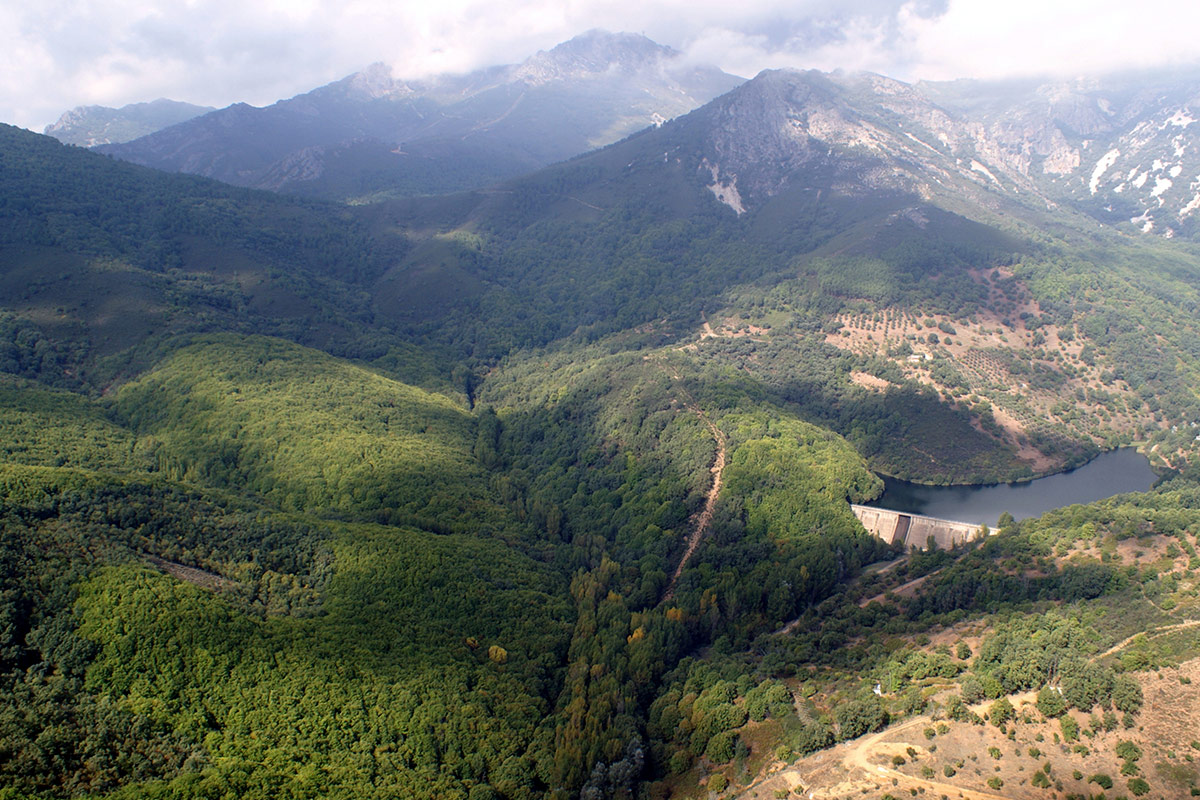LOCATION AND ACCESS
To reach the upper course of the Guadalupe River we must take a forest track that leads off the old road (EX-380) on a sharp bend behind the ruins of the “Electricity Factory” one kilometre southwest of the town of Guadalupe.
Geoparque Mundial UNESCO
Geoparque Villuercas > Nº14 – Guadalupe River and Ravine of Valdegracia
To reach the upper course of the Guadalupe River we must take a forest track that leads off the old road (EX-380) on a sharp bend behind the ruins of the “Electricity Factory” one kilometre southwest of the town of Guadalupe.
From the valley we can see the nearby conical crag of Picoagudo, a quartzite witness hill that resisted the erosion that has worn down the Hercynian cupola of the Guadalupe anticline.
From its source in the pedreras of Los Hollicios in the southern area of La Villuerca to its mouth in the Guadiana near Valdecaballeros, the River Guadalupe is of outstanding geological, ecological, and aesthetic value. The excellent state of preservation of its upper section, which has been protected as an Ecological and Biodiversity Corridor since 2003, means that we can find here outstanding plant formations such as riverside woodland of willows, ashes, black poplars, and alders or others associated with margins, generally pasturelands of grasses and mixed woodland of evergreen oaks and cork oaks. It also holds a large number of protected mammal and bird species: the otter, shrew, wild cat, marten, black stork, eagle owl, scops owl, booted eagle and short-toed eagle, kites, black-shouldered kite, goshawk, sparrowhawk, lesser kestrel… and many aquatic birds.
As far as history is concerned we must mention the abundance of mills, fulling mills, and water mills that were built by the Hieronymite monks on the banks of the River Guadalupe. In his Itinerarium Hispanicum of 1494-1495 the German traveller Münzer tells us that Queen Isabel the Catholic spoke of this beautiful and exuberant landscape that surrounds Guadalupe as “her paradise”.

The materials that make up the valleys of these rivers are those of the core and the southwest flank of the great Ibor-Guadalupe anticline, which is some 15 km wide at this point and has been worn down by erosion to reach the deepest area of the so-called “Grupo Ibor” from the Upper Neoproterozoic or Ediacaran (some 550 million years ago).
Lithologically the series consists of shale and chalco-schist strata alternating with others of sandstone and conglomerates. Among these are inserted some discontinuous levels of dolomite limestone some 25 m thick and bluish in colour, which outcrop in the vicinity of the Granja de Mirabel adjacent to some old limestone kilns, where they were exploited so as to build their hamlet and the historical Monasterio de Guadalupe. These calcareous rocks appear on the other flank of the Ibor-Guadalupe anticline near the hamlet of La Calera (Alía), where they were also extracted for lime manufacture (see Geosite no. 8 “Hornos de La Calera”).
In the shale remains of algae filaments of the genus Vendotaenia are frequently met with, and the limestone contains marine algae (stromatolites) that can be dated as being from the Ediacaran period; this reveals that the rocks originated as a wide marine platform.
The area currently features strong relief elements towards the north owing to recent faults of some significance from the final phase of Alpine orogeny; these constitute the watershed between the river basins of the Tajo to the north and the Guadiana to the south.
